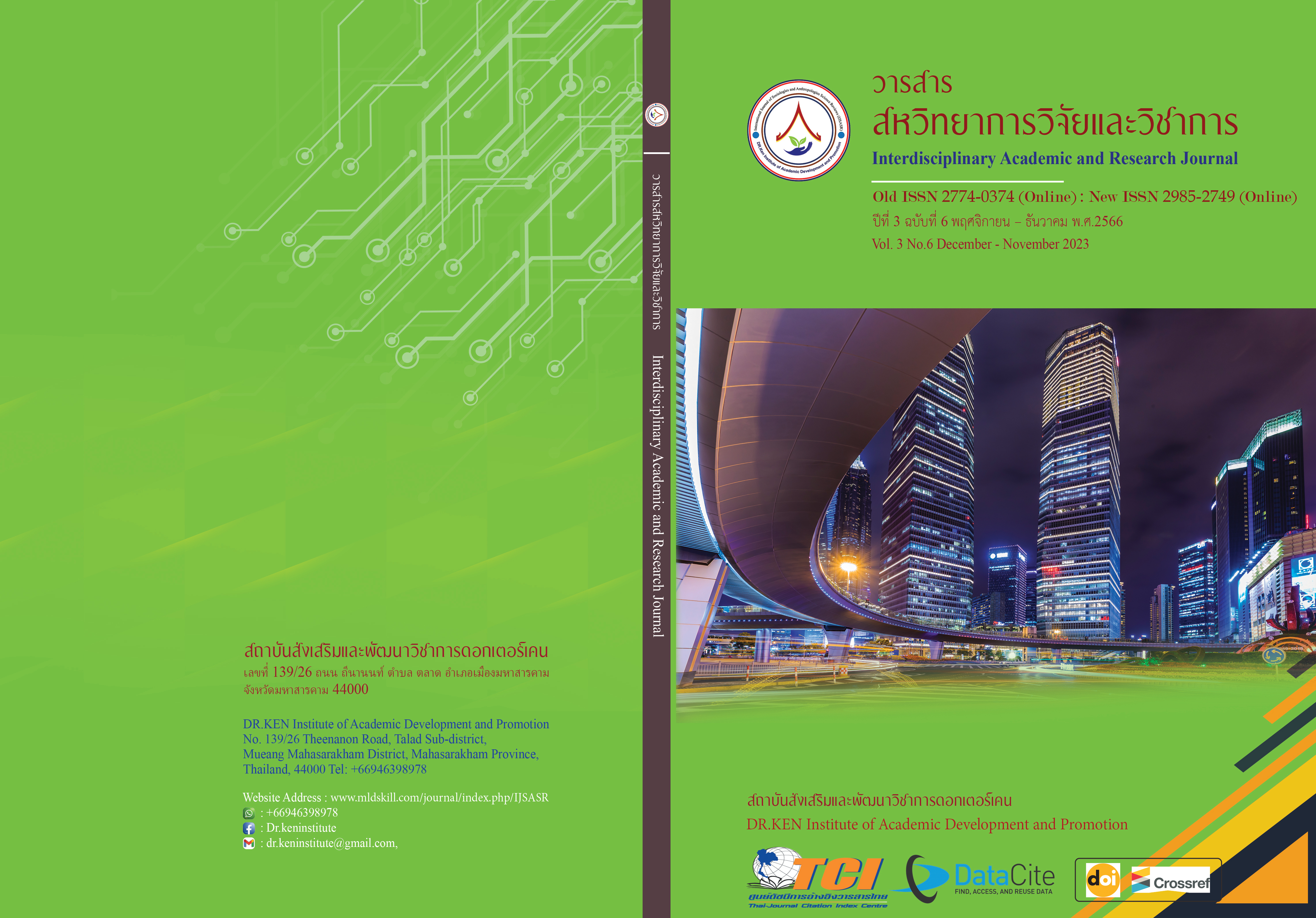Using the LINCS Strategies to Develop English Vocabulary in Communicative English for Career Course of Third-Year Students Majoring in Industrial Management at Thepsatri Rajabhat University
DOI:
https://doi.org/10.60027/iarj.2023.271014Keywords:
LINCS Strategy; , English Vocabulary; , Communicative English for CareersAbstract
Background and Aims: English is the lingua franca of communication as more than a quarter of the world's population is proficient in English from a practical to fluent level and the number is likely to increase. In addition to the use of English for communication, in most industrial sectors, tools or systems are used in English as well. The purposes of this research were 1) to develop a learning management plan using the LINCS strategies, 2) to compare the students’ English vocabulary before and after learning management using the LINCS strategies, 3) to compare learning achievements before and after learning management using the LINCS strategies, and 4) to explore students’ satisfaction towards learning management.
Methodology: The population was 20 third-year students majoring in industrial management from the faculty of Industrial Technology at Thepsatri Rajabhat University in the second semester. The instruments were learning management using the LINCS strategies, the English vocabulary test, the achievement test, and Students’ satisfaction on the learning management questionnaire. The statistical devices were mean and SD.
Results: the results were as follows: (1) Overall, the content validity of the learning management plan using the LINCS strategies had an average of 4.68 and was at the highest level of appropriateness. (2) The students’ English vocabulary after learning was higher than before the treatment, with a difference of +7.76. (3) The academic achievement of students after learning the LINCS strategies was higher than before the treatment, with a difference of +13.09. And (4) Overall, the students’ satisfaction with learning management was at the highest level.
Conclusions: Research shows that LINCS-based learning plans are accurate and have high averages, resulting in increased student knowledge and competency, and increased learning satisfaction.
References
กาญจนา จันทร์พราหมณ์. (2563). ความต้องการในการใช้ภาษาอังกฤษของพนักงานระดับปฏิบัติการในนิคมอุตสาหกรรมจังหวัดชลบุรี. วารสารสังคมศาสตร์และมานุษยวิทยาเชิงพุทธ. 5(8), 425-436.
ชนิดา เจนนพกาญจน์. (2552). การศึกษาผลสัมฤทธิ์ในการเรียนรู้และความคงทนในการจำคำศัพท์ของนักเรียนชั้นประถมศึกษาปีที่ 6 จากการสอนโดยกลวิธีลินซ์ (LINCS STRATEGY) วิทยานิพนธ์ศิลปศาสตรมหาบัณฑิต. ภาควิชาหลักสูตรและการสอน คณะศึกษาศาสตร์ มหาวิทยาลัยศรีนครินทรวิโรฒ.
ณัฐพงษ์ พลหน่วยตระกูล. (2560). การจัดกิจกรรมการเรียนการสอนโดยใช้กลวิธีการเรียนรู้คำศัพท์เพื่อพัฒนาความรู้คำศัพท์และความสามารถในการอ่านภาษาอังกฤษของนักเรียนชั้นประถมศึกษาปีที่ 5 โรงเรียนหนองสิมโนนสวรรค์ สำนักงานเขตพื้นที่การศึกษาประถมศึกษาบึงกาฬ. ศึกษาศาสตร์สาร มหาวิทยาลัยเชียงใหม่. 1(3), 1-14
บุญชม ศรีสะอาด. (2560). การวิจัยเบื้องต้น. พิมพ์ครั้งที่ 10. กรุงเทพฯ: สุวีริยาสาส์น.
ปวีณา บุตรวงค์. (2558). ผลการเรียนรู้และความคงทนการจำคำศัพท์ของนักเรียนชั้นมัธยมศึกษาปีที่ 2 โดยใช้กลวิธีลินซ์ร่วมกับเทคนิคเพื่อนคู่คิด. วารสารวิทยาการวิจัยและวิทยาการปัญญา. 13(2), 45-56.
พรรณี ลีกิจวัฒนะ. (2559). วิธีการวิจัยทางการศึกษา. พิมพ์ครั้งที่ 9. กรุงเทพฯ: มีน เซอร์วิสซัพพลาย.
มหาวิทยาลัยราชภัฏเทพสตรี. (2562). หลักสูตรอุตสาหกรรมศาสตรบัณฑิต (อส.บ.) สาขาวิชาเทคโนโลยีอุตสาหกรรม หลักสูตรปรับปรุง พุทธศักราช 2562. ลพบุรี: มหาวิทยาลัยราชภัฏเทพสตรี
Anderson, R. C. and Freebody, P. (1981). Vocabulary Knowledge. In Guthrie, J.T. (Ed.), Comprehension and teaching: Research reviews. Newark, DE: International Reading Association.
Cronbach, L. J. (1970). Essentials of Psychological Test. 5th edition. New York: Harper Collins.
Dakun, W. and Gieve, S. (2008). Learning environments and the use of vocabulary learning strategies: A Case study of Chinese learners. Language Learning Journal, 36(2), 175-191.
Ellis, E. S. (1998). Visual and Auditory LINCS to Background Knowledge: A Key for Learning New Terms. Alabama: Masterminds.
Hirsh, D., & Nation, P. (1992). What Vocabulary Size Is Needed to Read Unsimplified Texts for Pleasure? Reading in a Foreign Language, 8, 689-696.
Hulstijin, J.H., Merel Hollander, and Tine Greidanu. (1996). Incidental vocabulary learning by advanced foreign language students: The influence of marginal glosses, dictionary use, and reoccurrence of unknown words. The Modern Language Journal. 80 (3), 327-339.
Schmitt, N. (2000). Vocabulary in language teaching. Cambridge: Cambridge University Press.
Wilkins, D.A. (1972). Linguistics and Language Teaching. London: Edward Arnold.
Downloads
Published
How to Cite
Issue
Section
License
Copyright (c) 2023 Asst.prof. Veeravit Boonsong, Ph.D., Asst.prof.Wipasiri Jaengsaengthong

This work is licensed under a Creative Commons Attribution-NonCommercial-NoDerivatives 4.0 International License.
Copyright on any article in the Interdisciplinary Academic and Research Journal is retained by the author(s) under the under the Creative Commons Attribution-NonCommercial-NoDerivatives 4.0 International License. Permission to use text, content, images, etc. of publication. Any user to read, download, copy, distribute, print, search, or link to the full texts of articles, crawl them for indexing, pass them as data to software, or use them for any other lawful purpose. But do not use it for commercial use or with the intent to benefit any business.
















.png)


